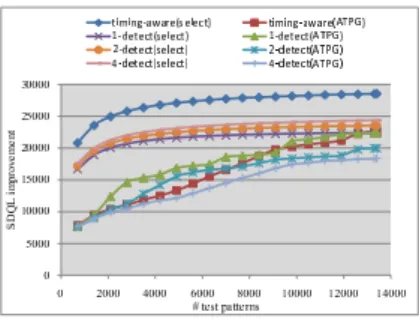Test Pattern Selection to Optimize Delay Test
Quality with a Limited Size of Test Set
Michiko Inoue∗†, Akira Taketani∗, Tomokazu Yoneda∗†, Hiroshi Iwata∗ and Hideo Fujiwara∗†
∗Graduate School of Information Science, Nara Institute of Science and Technology
†Japan Science and Technology Agency, CREST
Abstract—Timing-aware ATPGs are being developed to detect small delay faults for high defect coverage for current nanometer VLSI design. However, it results in a large test set compared with test generation targeting traditional fault models. This paper proposes a method to get a limited size of test set with high delay test quality based on statistical delay quality level (SDQL).
I. INTRODUCTION
We address the problem to generate a small test set with high delay test quality. Unlike related works [1], [2], we adopt statistical delay quality level (SDQL)[3] as a delay test quality. The SDQL shows the amount of delay defects that should be detected but cannot be detected. It is defined as follow.
SDQL= !
f ∈N
" Tdetf Tmgnf
F(s)ds (1)
In the definition, N is the total number of faults, F(s) is a delay defect distribution function and Tmgnf and Tdetf are the minimum delay defect sizes of a fault f that can affect system behavior and is detected by a given test set, respectively.
II. TESTSETSELECTIONMETHOD
To generate a test set with the minimum SDQL under a constraint on test pattern count, 1) we first generate a base test set Tbase according to some criteria, then 2) select the required number of test patterns from Tbase. The proposed selection method first obtains, for each test pattern, an SDQL value and the minimum delay defect sizes detectable by the pattern for all the faults and select a test pattern with the minimum SDQL as the first pattern. From the second pattern, we efficiently select test patterns one by one based on the descrease of the sum of Tdetf − Tmgnf for all the faults. Experiments. We evaluated the proposed selection method by comparison with two methods: 1) generate a limited number of test patterns by ATPG (ATPG order) and 2) select a test pattern
TABLE I
BASE TEST SET GENERATION AND SELECTION RESULTS. selection time(s) circuit #faults #patterns TGT(s)
proposed coverage
b14 22,904 1,325 2,429.06 195.89 28.15
b15 26,428 1,793 439.21 80.34 20.72
b17 80,612 5,745 2,193.66 602.93 198.74
b18 223,312 13,030 32,898.94 5,559.22 1,312.01 b19 433,410 24,058 103,917.61 26,556.51 5,342.22 b20 46,538 3,894 14,542.42 1,094.56 173.23
Fig. 1. SDQL and selection method for b19.
Fig. 2. SDQL and base test set for b19.
from Tbasebased on transition fault coverage (coverage based). We used TetraMAX(Synopsys) and SunFireX4100 (3.0GHz CPU and 16GB memory, Sun Microsystems). Table I shows the results for ITC benchmark circuits. Figure 1 shows the im- provement of SDQL value from the SDQL value for an empty test set, where Tbase is generated by timing-aware ATPG. From these results, we can find that the proposed method efficiently improves SDQL. Next, we compared several ATPGs to find a suitable base test set. Figure 2 shows the SDQL improvement for b19. We can find that timing-aware ATPG is suitable to obtain high delay test quality.
REFERENCES
[1] M. C.-T. Chao, L.-C. Wang, and K.-T. Cheng, “Pattern selection for testing of deep sub-micron timing defects,” in Proc. of the Design, Automation and Test in Europe, 2004, pp. 1060–1065.
[2] Z. Wang and K. Chakrabarty, “Test-quality/cost optimization using output-deviation-based reordering of test patterns,” IEEE Trans. on Computer-Aided Design on Integration Circuits and Systems, vol. 27, no. 2, pp. 352–365, 2008.
[3] Y. Sato, S. Hamada, T. Maeda, A. Takatori, Y. Nozuyama, and S. Kajihara,
“Invisible delay quality ? SDQM model lights up what could not be seen,” in Proc. of the International Test Conference 2005, 2005, p. 47.1.
